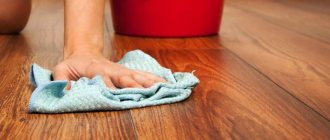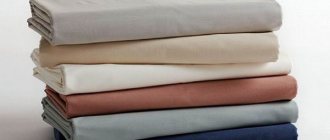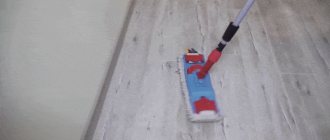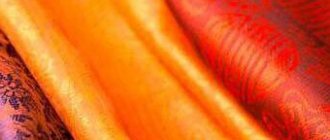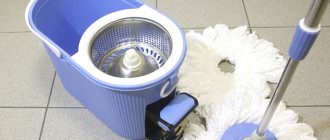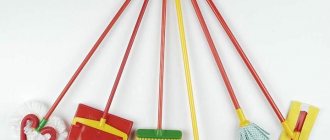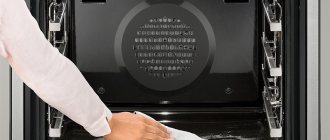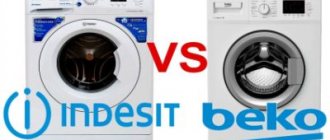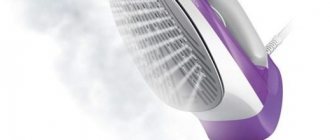How to save precious minutes of free time if you have to use it to wash floors in an apartment is a serious question. Housewives, as a rule, treat the process without much enthusiasm, and for many this is a whole problem. But we all understand that not only the well-groomed appearance of our home, but also the health of the family directly depends on cleanliness.
Cleaning makes the air we breathe cleaner. This stage cannot be ignored, but it can be greatly simplified. The right cleaning equipment is already 50% of your success. Floor cloth, made in various ways (non-woven, stitched, printed), is the first thing to start with.
General tips for choosing a rag
Household goods stores offer customers a wide range of floor cleaning cloths. Each product differs in the material it is made of, its texture and functional characteristics.
When choosing a rag, you need to take into account that the floor fabric should quickly absorb moisture and be soft. When purchasing a rag for cleaning floors, you need to pay attention to its characteristics. The floor rag should:
- absorb dirt rather than smear it;
- good at collecting dust;
- do not leave streaks or lint;
- easy to do push-ups;
- serve for a long time.
Material selection
A wide range is created to make it easier to choose a product, but in some cases this leads to confusion for the buyer. It is not so easy to choose the right cloth for cleaning your floors. Rags are made from natural or synthetic material. Each of them has its own advantages and disadvantages. We will talk about the following fabrics:
- cotton;
- viscose;
- polyamide;
- acrylic;
- microfiber.
The latter material can be considered innovative. Appearing on the household goods market relatively recently, it managed to win the hearts of many housewives.
We recommend: Choosing a cat litter cleaner and its proper disinfection
Choosing a rag depending on the material
The material used can be natural or artificial. Its choice depends on the floor covering: wood, tile, laminate, linoleum, cork panels, parquet or self-leveling surface. The most common floor cloths are made from natural cotton and synthetic fibers - acrylic, viscose, microfiber and polyamide.
Each product has its positive and negative sides. But any fabric must be periodically disinfected, washed at +40°C and used only for cleaning the floor.
Cotton
A cotton floor cleaning cloth is excellent for cleaning both rooms and rooms with high humidity. The material is breathable and hypoallergenic. It quickly and efficiently absorbs moisture. During cleaning, it does not leave loose threads on the surface, since cotton fibers are characterized by tight adhesion and do not require processing of the edges of the fabric.
The product is pleasant to the touch. It does not stretch and easily survives repeated washings.
In addition to a large number of advantages, cotton fabric also has disadvantages:
- A natural floor cloth may leave streaks on a glossy polished surface.
- It loses its shape after constant use.
- May shrink during heat treatment.
- The fabric wipes quickly.
Today on sale you can find cleaning cloths made of cotton thread with the addition of polyester. Such products last longer and do not leave streaks when wiping the surface.
Viscose
Viscose is a material of artificial origin. When making cleaning rags, they use a fabric that is not silk-like, but a porous fabric made of viscose fibers.
Such products are characterized by increased strength and durability. Most often they are sold in separate packages, but you can purchase viscose floor rags in a roll. In the latter case, the cost of the product will be indicated per 1 m.
Viscose fabric is produced from cellulose. The process is considered environmentally friendly. The fabric has a number of advantages:
- It has a smooth surface, so it does not leave threads or lint during cleaning.
- It has good hygroscopicity. After wiping, you get a clean floor without streaks.
- The product lasts a long time and does not lose color or shape during use.
Viscose copes well with small amounts of dirt. The most suitable flooring for it is linoleum. Viscose fabric is not suitable for use in kitchens, bathrooms or toilets.
The material does not tolerate high temperatures well, so it is recommended to use cold water during cleaning. If you try to wipe away heavy dirt, marks may remain on the floor. For this purpose, it is better to use fabric with polyester additives.
Acrylic
Natural gas is used in the production of acrylic. The fabric feels like wool. It is completely hypoallergenic and retains its color and shape perfectly. The canvas can interact with alkaline or acid-containing substances and is not deformable.
Acrylic fiber floor rags are not suitable for wet cleaning. Acrylic is an airtight material with a low hygroscopicity, so it is used when rubbing parquet or laminate to give the coating a characteristic shine.
Polyamide
Polyamide is a material of artificial origin, which is characterized by high elasticity and wear resistance. The fabric is pleasant to the touch and light. It does not change its color and shape even after numerous cleanings. In addition, polyamide is characterized by resistance to decay. It doesn't grow mold.
Polyamide is indispensable in rooms with high humidity. It is not afraid of interaction with aggressive detergents and disinfectants.
Products made from polyamide are expensive, but this disadvantage is offset by the high characteristics of the material.
Microfiber
Microfiber was invented in Japan, but today it is popular all over the world. The canvas consists of ultra-fine fibers that perfectly absorb water, dust and dirt. Despite its excellent performance, the microfiber floor cloth is not intended for use in the kitchen.
The advantages of the canvas include:
- High hygroscopicity, which is 4 times higher than any other matter. There is a lot of space between the fibers of such a rag, which allows it to easily and quickly absorb water. At the same time, during squeezing, the liquid practically does not linger in the fabric, which allows you to get a completely dry fabric.
- Does not leave lint on the wiped surface.
- Does not change color fastness. Even when using warm water, the rag will retain its rich original color. It will not fade or fade.
This material also has disadvantages:
- The canvas does not tolerate high temperatures. It is not recommended to wash microfiber products in hot water or dry them on a radiator.
- The fabric accumulates static electricity, which serves as an attraction for dust particles. Therefore, the linen has to be cleaned more often than rags made from other fabrics.
- All beneficial characteristics are lost upon contact with fat.
Cotton
Cotton is a good helper when performing general cleaning in the house. Natural fabric demonstrates excellent moisture absorption and breathability. In addition, it is pleasant to the touch. However, the benefits don't end there.
Of all natural fabrics, cotton stands out for its comparative strength. The threads along the edges do not fray even without additional processing. Such rags do not stretch and easily survive repeated washings.
Despite the list of advantages, cotton rags have a number of disadvantages:
- wipe quickly;
- shrink after heat treatment;
- lose shape during cleaning;
- may leave divorces.
Cotton rags with the addition of polyester are durable and leave fewer streaks on the parquet.
What size floor cloth should I choose?
A rag intended for cleaning floors, which is sold in individual packaging, immediately has the most suitable size. The optimal parameters are: length 60 and width 50 cm. If the product is a material in a roll, it is recommended to take a piece of the same size.
In addition, there are products with dimensions of 60x60, 75x80 and 75x100 cm. Small rags allow you to clean hard-to-reach places and wipe small parts. Large cloths are designed for cleaning floors in spacious rooms. You can purchase a whole roll for office cleaning.
Viscose
Viscose is a representative of the group of synthetic fabrics. For cleaning floors, they do not use a fabric resembling silk, but a porous material made from viscose fiber. The main quality is increased strength, which significantly extends the service life. Viscose is sold not only in individual packages, but also in rolls. In this case, the price will be indicated per linear meter.
The material is obtained by processing cellulose. The process is environmentally friendly. Unlike cotton, viscose rag has a number of features:
- higher hygroscopicity (absorbs moisture better);
- does not leave lint or threads on the floor due to its smooth surface;
- does not lose shape after washing;
- does not fade, does not lose its appearance.
Among the disadvantages, housewives note instability to high temperatures. When using such a product, the water in the rinse bucket should be cold. The second drawback is the remaining stains when trying to clean an excessively dirty floor. This can be avoided by choosing a rag that contains viscose and polyester.
Polyamide
Another type of synthetic cleaning cloth. Polyamide is very elastic, it dries quickly and is resistant to mechanical stress. Even after repeated cleanings, its shape and color remain unchanged. The fabric is pleasant to the touch, light and airy. A significant plus is resistance to fungi and rotting.
We recommend: There will be no more mold: three penny remedies for fungus on the elastic band of the washing machine
Among the disadvantages of this material, one can only note the rather high price. However, as reviews from satisfied housewives show, the price is very justified.
Fabrics of synthetic origin
Today you can buy floor rags not only from natural fabrics, but also from fabrics of synthetic origin. Despite their unnaturalness, they are in great demand and have excellent qualities. To produce such rags, various raw materials are used, ranging from oil to glass and metal .
Acrylic rags and polyamide
Acrylic is an artificial fabric made from acrylic acid. In appearance it is similar to wool. That is why it is often used to polish parquet floors to a shine.
Polyamide is a fairly durable fabric that not only has a pleasant-to-touch surface, but also an attractive appearance. After cleaning with such a rag, the floor not only becomes shiny and clean, but also dries quickly. With proper care, fabric of this type will last a long time without losing its original appearance. Today you can find floor cleaning cloths in rolls, which are made of polyamide. They are most often purchased for production and enterprises, as they have a large footage.
Quality of canvas stitching
The canvas-stitched fabric has the following qualities: repeated use, excellent absorption of liquids, high dust absorption, suitable for both dry and wet cleaning. In production, canvas-stitched fabric is used for wiping parts, tools, equipment, in car services and laboratories.
Non-woven fabric of the highest quality is made from primary cotton raw materials. The quality of this material also depends on the frequency of stitching. The durability and quality of canvas stitching also depends on the length of the fibers; the longer it is, the better. CPP, which is produced from primary raw materials, is white; this fabric can also be gray or black. Plus, recycled materials such as scraps and fabric scraps are used to make non-woven fabric. Non-woven fabric (NCF) is often used for washing floors, for cleaning premises, and is also widely used as a cleaning agent. In addition, the canvas-stitched fabric absorbs detergent very well, thereby making cleaning more economical. In the manufacture of furniture, it is also used as a cushioning material or, for example, as insulation for shoes and clothing. When moving and transporting various fragile materials, CPP is used for their packaging.
Acrylic
The production of this material is based on natural gas. Acrylic is resistant to shape. It feels like wool to the touch. The material is hypoallergenic, retains color, and does not deform when interacting with acids and alkalis.
Advice
Do not use acrylic for wet cleaning.
A significant disadvantage is low hygroscopicity. The fabric is practically airtight and absorbs water very poorly. Because of this, acrylic rags are used for rubbing floors with a shiny surface (parquet or laminate), and not for wet cleaning.
